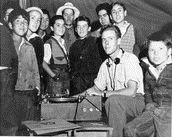|
Lesson Overview
 | Using Oral HistoryTeacher Material |
Overview | Materials and Preparation |
Instructional Procedure | Evaluation and Extension
Evaluation
- Ask each student to write a one-page essay on one of the following topics:
- What was the most significant change in the lives of everyday Americans identified
by your research? What evidence did you find of this change? What other sources might you
consult to confirm the significance of this change?
- Why do you think oral history is a useful tool for understanding the past? What are
oral history's strengths? What are its limitations?
- Students can work in their groups to create museum displays on their social history topics.
Displays should:
- illustrate significant changes in the lives of everyday Americans identified by the group's research;
- provide evidence in support of those changes (such as excerpts from class interviews and the American
Life Histories collection, artifacts, and information from other sources).
Extension
- Encourage students to search the American Memory collection,
Color Photographs from the Farm Security Administration and the Office
of War Information, ca. 1939-1945, for visual sources related to
automobiles, dancing, women's work, or topics they pursued in their own
oral histories. The following questions may help students select and analyze
the photographs:
- Do the photographs support the results of your oral history interviews and background research? If so, how?
- Do the photographs refute the social history conclusions you made in this lesson? If so, how?
- Do the photographs provide evidence of changes over time? Why or why not?
- Students can host an open house for their interviewees during which they present their displays.
|



